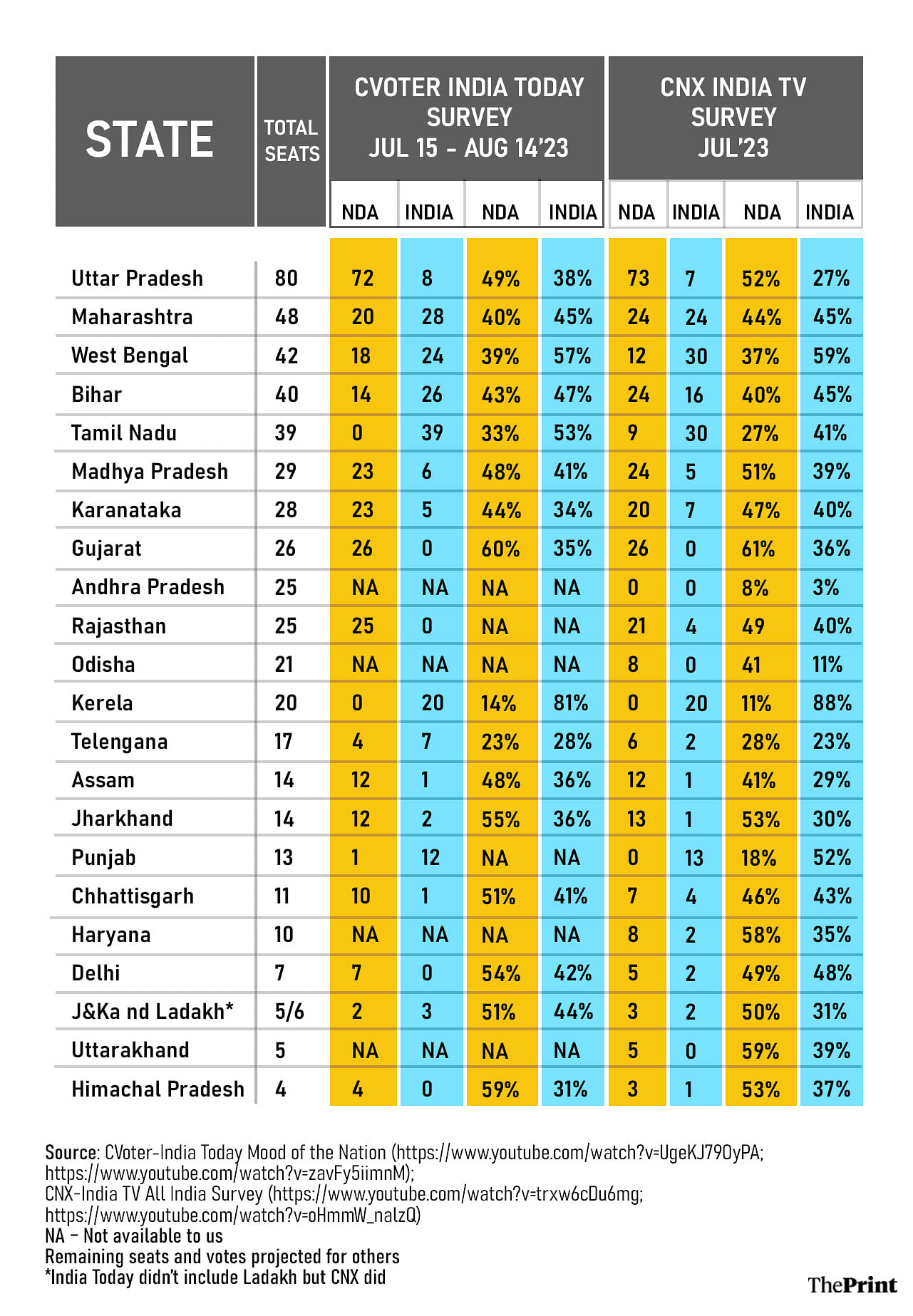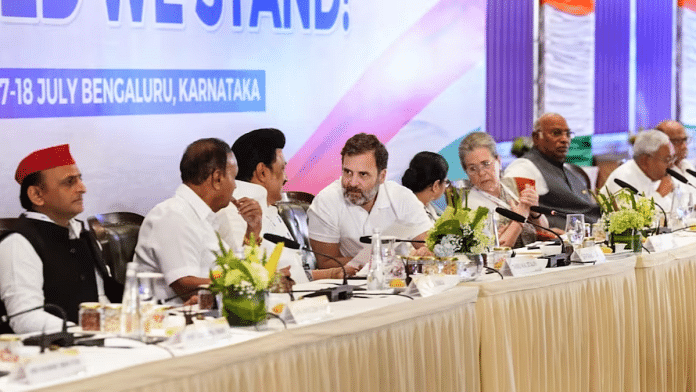Here is good news and bad news for INDIA coalition partners to deliberate in their ongoing Mumbai meet. Bad news first: The Bharatiya Janata Party continues to be the frontrunner for the 2024 Lok Sabha election, well ahead of the combined strength of the newly forged opposition alliance. Yet there is much good news hidden behind this depressing headline. INDIA is gaining traction in crucial geographies. Anti-incumbency is setting in, at least on some critical issues. And what many call the ‘Modani’ charge is beginning to bite. All in all, 2024 is still an open race.
The news comes from two recent nationwide surveys that have been released over the past month. One poll was conducted by CNX for India TV and the other by CVoter for India Today as part of its bi-annual Mood of the Nation series. They have offered similar projections if the Lok Sabha election was to be held today – a clear but reduced majority for the BJP. Based on its survey among over 44,500 adults across 292 parliamentary constituencies in July 2023, CNX predicts a total of 318 seats for the National Democratic Alliance (NDA), with 290 for BJP alone, and 175 for INDIA, with 66 for the Congress. The CVoter polled nearly 26,000 people in all 543 parliamentary constituencies from mid-July to mid-August and supplemented their analysis with around 1,35,000 interviews from their tracker data. It puts NDA at 306 seats (BJP 287) and INDIA at 193 (Congress 74) in the event of a snap election.

These numbers don’t need to be taken too seriously. Seats forecast nine months before actual polls can only be broadly indicative. And while their sample size is big, the methodology adopted by both these polls leaves much to be desired. The CVoter survey was conducted over the phone, a poor substitute for direct face-to-face conversation with a random sample of the entire voting population. The CNX poll does not care to spell out its methodology. Such surveys are likely to under-sample marginal sections of society that tend to vote more for the opposition parties. Nevertheless, these survey findings offer four broad lessons for INDIA coalition leaders.
Also read: INDIA needs a new vision of nationalism for 2024. Invoking Nehru, Constitution not enough
BJP strategists’ reason to worry
First, the BJP is more vulnerable than it looks. The vote share figures suggest a much closer fight than the seat share numbers would have us believe. According to CVoter, while the NDA is securing around 43 per cent votes nationally at the moment, the combined vote share of all the INDIA alliance parties is merely 2 points behind — at 41 per cent. The BJP had reached saturation level in most of its strongholds in 2019. It can only lose in the north-west region.
The surveys show that INDIA is making some big and several small gains in these BJP-dominated states. Big gains come from Maharashtra and Bihar, where an opposition coalition is already up and running on the ground. Both surveys predict a split verdict in Maharashtra, accounting for a loss of around 17-21 seats for the NDA. Their readings differ for Bihar, but either way, it is a loss of at least 15 seats for NDA. These two states, along with West Bengal, Karnataka, Madhya Pradesh, and Rajasthan, where the surveys find the INDIA coalition to be making modest single-digit gains at present, can bring the BJP below the majority mark.
To make up for these losses, the BJP would need to add to its tally in some of the states where it has been virtually absent. But the surveys report a no-go for the BJP in Kerala, Andhra Pradesh, Punjab, and Tamil Nadu (except a small gain for its allies) and no improvement in Odisha and Telangana. So, BJP strategists have reasons to worry.
Also read: CAA, Article 370 abrogation, cow protection laws — what would Oppn bloc change if…
The game-changers
Second, there is growing anti-incumbency below the surface, provided the opposition knows where and how to tap it. On the face of it, three out of five people interviewed by CVoter approved of the government’s (59 per cent) and Prime Minister Narendra Modi’s (63 per cent) performance, just a slight dip compared to January 2023. Over half the voters (52 per cent) preferred Modi for the post of prime minister. His nearest competitor, Rahul Gandhi, was at 16 per cent despite a boost after the Bharat Jodo Yatra. So, it would be unwise for the opposition to foreground the Modi versus Rahul contest at this stage. This is not the time for INDIA to debate “Kaun banega pradhan mantri”.
Similarly, while issues related to democracy, communal harmony, safety of minorities, and freedom of expression mattered a shade more than in the past, especially among the minorities, these issues are unlikely to be game-changers. Strange though it is, the Modi government was rated favourably (70 per cent) on the foreign policy front and was able to persuade a large majority (79 per cent) that the government had handled the China border intrusions satisfactorily.
The lesson for the opposition is to focus, instead, on the economy. Only 47 per cent thought that the economy was being handled well by the government, compared to 54 per cent in January. In a match-up with former PM Manmohan Singh on the issue of handling the economy, Modi was found to be only 2 percentage points ahead of his predecessor, compared to a 15-point lead that he had held just eight months ago. Not surprisingly, most voters were found to be anxious about the inflation and unemployment situation. They were also pessimistic about the state of the economy and their own household incomes in the future, a pattern contrary to the general optimism of the Indian voter.
Specifically, there is a strong suspicion about this government’s links with big business. Most respondents (55 per cent) believed that big businesses have benefited the most from the Modi government’s policies as against one-fourth who thought that the benefits had gone to small businesses, the salaried class, or the farmers. The India Today magazine reports a critical finding (curiously missing from the TV programme): Nearly half of the respondents agree, while just one-third disagree, with Rahul Gandhi’s allegations that the Adani Group is getting favourable treatment from the BJP government. A plurality also believed in the Hindenburg report’s allegations against the Adani Group. Herein lies an opportunity for the INDIA alliance to disrupt Modi’s quest for the third term.
Third, Uttar Pradesh remains the Achilles’ heel for the opposition. Both the surveys suggest that the BJP was headed not just to repeat but actually improve upon its tally of 62 (64 with allies) seats in 2019 in a state where it has not lost any major election since 2014. With the BJP projected to secure a majority of the vote share, even an alliance of the Samajwadi Party (SP), Congress, and the Rashtriya Lok Dal (RLD), which has still not taken shape on the ground, would be no match for the BJP. True, the survey shows that Chief Minister Yogi Adityanath’s popularity is overstated. But it is an uphill battle for the INDIA coalition unless its leaders find a way to forge a much wider political as well as social alliance encompassing lower Other Backward Classes (OBCs) and Dalits.
Also read: CAA, Article 370 abrogation, cow protection laws — what would Oppn bloc change if…
2024 an open race
Finally, the fate of INDIA hangs on the performance of the Congress party. Both the surveys offer a dismal tally for the Congress — around 65-75 seats. Yet, among all the constituents of INDIA, the Congress has the maximum headroom to grow further. These surveys indicate that the Congress is placed very unfavourably in states such as Rajasthan, Madhya Pradesh, Chhattisgarh, Gujarat, Karnataka, Uttarakhand, and Himachal Pradesh, where it is locked in a straight contest with the BJP on all or most seats. Unless and until the Congress registers a substantial improvement in its tally, the INDIA coalition cannot possibly deny the BJP another term in office even if other constituents such as the Trinamool Congress (TMC), Dravida Munnetra Kazhagam (DMK), Janata Dal (United), and Rashtriya Janata Dal (RJD) do their bit. True, both surveys do record a slight uptick in the Congress’s tally (5-6 in Madhya Pradesh, 0-4 in Rajasthan, 5-7 in Karnataka), and a distinct improvement in the party’s vote share. In Rajasthan and MP, for instance, the BJP’s lead over the Congress in the parliamentary election has been cut down from around 25 per cent in 2019 to 8 per cent in Rajasthan and around 10 per cent in MP in the latest poll. Congress must win 100 plus seats (ideally around 125) for the INDIA coalition to have a realistic chance of forming the government.
The 2024 election remains an open race, provided the INDIA leaders gathered in Mumbai resolve their internal issues soon and turn their attention to these external challenges and opportunities.
Yogendra Yadav is National Convener of the Bharat Jodo Abhiyan. He is also a co-founder of Jai Kisan Andolan and Swaraj India. Shreyas Sardesai is a survey researcher associated with the Bharat Jodo Abhiyan. Views are personal.
(Edited by Humra Laeeq)



